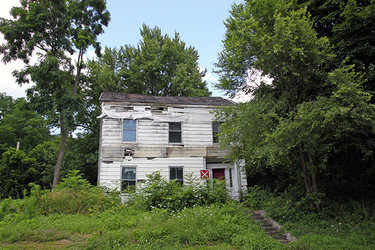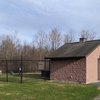Builder makes bid for Doctor Crounse House
ALTAMONT — Builder John Grennon had to abandon his last attempt to save the Dr. Frederick Crounse House because of his estimated cost to remove the building’s asbestos: $50,000. Now, based on a proposal from the citizens’ group Historic Altamont Inc., Grennon has made a pitch to the village of Altamont and town of Guilderland to buy the historic house from them for a dollar.
After notifying the village and town in June that it would no longer pursue a $300,000 grant that may have covered the entire cost of restoring the house, Historic Altamont asked that the municipalities consider taking out a $50,000 loan to remove asbestos from the home. The specific loan Historic Altamont has in mind is an Endangered Properties Intervention Program Loan from the New York State Preservation League, a not-for-profit organization.
Historic Altamont has said that it would raise the $50,000 to pay back the loan, which, it has said in the past, would be a better fiscal solution for the town and village because they would no longer have to pay to abate the asbestos and demolish the home.
In 2006, the town and village jointly paid $40,000 in back taxes to Albany County to purchase the Federal-style house built in 1833 by the area’s first doctor. Altamont’s mayor at the time, James Gaughan, described the condition of the building as “fair to good.” He envisioned housing the village’s extensive archives there, where visitors could learn about Altamont’s history.
But, instead, neither the town nor village did anything to restore or maintain the structure. The house fell into disrepair and the municipalities spent $25,000 in state grant money earmarked for a new roof for the Doctor Crounse House on other projects.
The house is located on Route 146 in Guilderland, on the outskirts of the village, in what had been the original center of development — Knowersville — before the train station moved the village and it changed its name to Altamont.
In a letter to Peter Barber, Guilderland’s supervisor, and Kerry Dineen, the mayor of Altamont, Grennon wrote, “I heard about the new plans to demolish the Crounse house. I was not able to make a concrete offer to take ownership last time because of the cost of asbestos abatement, but if the asbestos is abated I would make a new proposal.”
Grennon’s proposal, which is contingent on asbestos abatement, is to purchase the property from the town and village for $1; restore it within 12 to 18 months; and, once he obtains a certificate of occupancy, he will subdivide the parcel into two lots, and reserve the right to build a home on the rear lot of the post-subdivided property. He also agreed to accept any covenants or easements that the town and village wish to place on the property.
Grennon, who lives in Knox, specializes in historic restoration. He told The Enterprise that he got involved with the Doctor Crounse House again because he didn’t want to see the historic house torn down. “Anybody can rip it down, but you can’t put a 200-year-old building back up,” he said.
He estimates that the cost of restoring the home would be about $250,000.
Appearance alone isn’t enough of a reason to take down the house, Barber told The Enterprise, and, although he knows that Historic Altamont has said it would pay off the loan, he’d like to explore all options. Ultimately, he said, the goal is to preserve the house; however, there’s also the fact that the back of the building, which has been condemned, needs to be remedied in some way.
Additionally, Barber said, the town and village want to make sure they have an accurate understanding of what the asbestos abatement actually entails. Barber said he keeps hearing about the $50,000 estimate but he has yet to see any proof that that is what it would cost to abate the home.
There’s also the issue of being on the hook for a $50,000 loan — if, in fact, that’s what the abatement would cost. The town and village, Barber said, don’t want to take on that responsibility only to find out Historic Altamont wouldn’t be able to pay back the loan.
“Lack of enthusiasm” from village officials
Neither Mayor Dineen nor the village trustees responded this week to emailed questions from The Enterprise about the Crounse House.
Historic Altamont has tried unsuccessfully to save the Crounse House through grants and, now, it is trying to secure a loan. The Enterprise asked Capuano why Historic Altamont itself hadn’t taken ownership of the building; that way, the group could bypass the need of having to ask the town and village for help to save the house and, instead, could go after the loan itself.
Capuano, in a follow-up email, said that the fundraising needed to restore the house is dependent on two “very interconnected things”: “A vision for the house and excitement about its future.”
Capuano said that the a prior proposal for the house, turning it into a visitors’ center and exhibition space, could serve as a roadmap. While the town has been at least willing to listen, and had endorsed Historic Altamont’s pursuit of the $300,000 grant, Capuano wrote, “There has been no enthusiasm from the Village Board.”
How could fundraising for a village-centric space be done without the support of the village board, Capuano asks.
“The lack of enthusiasm from Village officials has always been a riddle to me,” Capuano wrote. “The explanations given have been two: 1) their prior decision to demolish and unwillingness to consider alternatives and 2) that it’s a terrible eyesore and unrestorable.”
Capuano said these are flawed explanations because people often revisit prior decisions and, when warranted, undo them.
“And as for the house being unrestorable, John Grennon’s proposal proves the opposite,” Capuano wrote. “Preservationists who have visited the house have told us the same: That it would take a lot of money, but that it could be done. The money is out there, in grants and loans, but apparently the interest is not.”
Capuano came to the village board in June with his $300,000 third “last shot” — looking for support to apply for a grant to save the Crounse House.
Dineen has told The Enterprise in the past that, prior to the June meeting where Historic Altamont made its pitch to save the house, the last time the village had heard from the group was in November 2018, when Historic Altamont had “arrived at the conclusion that the costs of asbestos testing and abatement” were “beyond” its “reach.” And, she said, the group had made the decision not to “pursue further the acquisition of the property.”
Further, Dineen has said, the village and town had made the decision to knock down the building long before Capuano’s June plea to save the house.
In an email to The Enterprise, the New York State Department of Labor said about the need to abate asbestos in a building slated for demolition, “If a property is to be demolished, an asbestos survey must be performed to identify the location, quantity, and type of asbestos in the building. In general, asbestos containing materials must be abated prior to demolition, however, based upon the survey results, there may be other options for the municipality. After a survey is completed the municipality can consult with a licensed asbestos contractor or contact the NYSDOL for abatement and demolition requirements.”
Grennon reasoned that, since the Doctor Crounse House asbestos problem has been brought to everyone’s attention, it can’t just be knocked down. So, it’s likely that the town and village would have to pay to abate the home prior demolition.
Through a Freedom of Information Law request, The Enterprise has found that the village hasn’t received any formal complaints about the building. In the last year, there was only one email exchange about the Crounse House, and that was with Capuano. At board meetings, Dineen has offered only anecdotal accounts of the public’s desire to tear down the dilapidated building.
Barber said that he’d never received any complaints about the house; however, he also points out that, given its prominence as a gateway to the village, most people may not realize that the house is actually in Guilderland.



